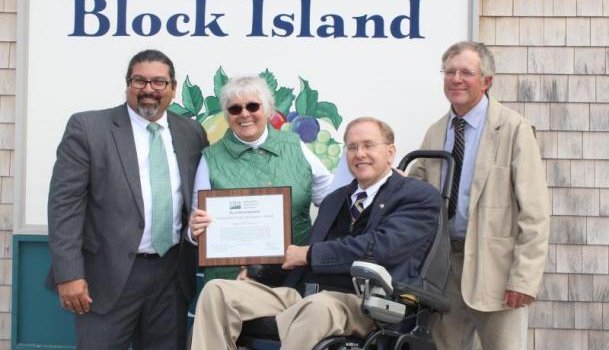Due to its small population, Block Island qualifies for all of the USDA’s Rural Development programs, which fall into four categories: water and environmental programs, community facilities, business and cooperative programs, and housing programs. There are three mechanisms by which the USDA facilitates projects – direct loans, guaranteed loans, and grants.
After an introduction by First Warden Ken Lacoste, USDA State Director Scott Soares provided an overview of the Rural Development Program and its role in Rhode Island. In the fiscal year that ended on Sept. 30, 2016, the USDA spent $37 million on programs in Rhode Island. About half of that was spent on housing programs, and half of that was spent in Washington County. Despite the amounts, many eligible organizations are not aware of the programs the USDA has to offer. Soares said that on Block Island, the USDA’s programs could possibly assist with the capping of the old landfill, the roll-out of broadband, and energy issues. “We’re looking at ways to work with Block Island to get at critical community infrastructure needs,” he said.
The USDA’s programs are not set in stone. Recent endeavors in Rhode Island have concentrated on food accessibility programs and the agency is now looking at ways it can assist in the opioid crises. Soares said that every year the programs get “tweaked.”
At the larger end of the scale, some programs are for municipalities to build infrastructure in the areas of water and sewage systems, solid waste programs and storm drainage. Help for rural businesses comes in the form of loan guarantees and grants for renewable energy systems and energy efficiency projects under the Rural Energy for America Program. Rural Business Development Grants are available to help small businesses in rural communities although they come in the form of “pass through” grants awarded to municipalities or not-for-profits as opposed to individual businesses. These can be used for job training and technical assistance, land acquisition and development and “farm labor housing.” There are even programs that provide assistance to low income individuals over 62 for emergency home repairs involving health and safety.
It was the REAP program that Block Island Grocery owner Mary Jane Balser most recently has taken advantage of. REAP grants will fund 25 percent of an energy efficiency project, and the BIG has been awarded two such grants – one for purchasing and installing high efficiency LED lighting at $8,238, and one for replacing refrigeration equipment and compressor upgrades in the amount of $20,000.
Balser said she was amazed at how much energy the store saved with the lighting alone. Instead of fluorescent lights that were on all of the time, the LED lights are on sensors so that only the amount of light that is needed is used. Just from replacing the lighting, the store has saved 35.6 percent of “their historical energy consumption.” The refrigeration component added an additional savings of 9.7 percent. She lauded the staff of the USDA for their assistance in applying for the programs.
Before being eligible for a REAP grant, one must perform a feasibility study, and USDA Energy Specialist Anne Correia said that other state agencies could assist with those, such as the RI Office of Energy Efficiency, which last year offered free energy audits for homes and businesses on Block Island.
After the meeting at Town Hall, the five representatives from the USDA reconvened at the Block Island Grocery where they and U.S. Representative James Langevin presented Balser with a Sustainable Energy Recognition Award. Balser thanked Langevin for coming out to the island and for the work he does on its behalf. “I’m proud of the island,” said Langevin. “I always brag about the island to my colleagues.”
The award reads in part: “Block Island Grocery is an example of environmental stewardship and a contributor to USDA’s overall mission of improving the quality of life for rural communities across the United States.”
Lacoste added that the BIG should also be recognized for providing employment and groceries to year-round families. Balser said she employs about 25 people in the off-season, and 100 during the summers.
A clearly delighted Balser led Langevin and the USDA team through the store, showing off her projects. When it came to explaining the changes in the coolers, she said: “They don’t drink just milk anymore. They drink Silk, soy and almond.” She even got Langevin to go inside the cooler for more show and tell.
But gratitude for the grants and the award was not the only thing on Balser’s mind. She thanked Langevin for being so accessible, and for visiting the island as frequently as he does, and praised the staff of the USDA for their helpfulness in obtaining the grants. And before the congressman left, she made sure to give him a smooch in the wine aisle.
Applications for USDA grants under $20,000 are due by Oct. 31, 2016 and by March 31, 2017 for grants over $20,000. Loans and loan guarantees may be applied for at any time of the year. For more information, go to the USDA’s website at www.rd.usda.gov.




